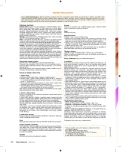What is the current stage of vulvovaginal discomfort diagnostics in the Czech Republic? Pilot analysis
Authors:
J. Kestřánek 1; P. Jílek 3; V. Matula 1; V. Buchta 2; M. Gregor 1; J. Špaček 1
Authors‘ workplace:
Porodnická a gynekologická klinika LF UK a FN, Hradec Králové, přednosta doc. MUDr. J. Špaček, Ph. D., IFEPAG
1; Mikrobiologický ústav LF UK a FN, Hradec Králové, přednosta doc. RNDr. V. Buchta, CSc.
2; Katedra biologických a lékařských věd FaF UK, Hradec Králové, vedoucí doc. PharmDr. P. Nachtigal, Ph. D.
3
Published in:
Ceska Gynekol 2013; 78(6): 522-527
Category:
Original Article
Overview
Objective:
To find out the level of the diagnostic effort of gynaecologists which is focused on the issue of vulvovaginal discomfort.
Design:
Pilot questionnaire study.
Settings:
Department of Obstetrics and Gynecology, Department of Clinical Microbiology, University Hospital and Medical Faculty Hradec Králové, Charles University, Prague, Department of Biological and Medici Sciences, FaF UK in Hradec Králové.
Methods and results:
The evaluation of selected parametres of entrance questionnaire in patiens with chronic vulvovaginal discomfort (itching, burning, discharge, vulvodynia more than 4 times a year). It has been confirmed, with the questionnaires, that almost no gynaecologists are interested in the issue of this matter.
Conclusion:
After evaluating the questionnaires a diversion of patient-tailored attitude has been found out, which can lead to negative consequences, particularly, in the future. Overuse of antibacterial and antimycotic medication and blind treatment have been prevailing.
Keywords:
vulvovaginal discomfort – miscroscopic examination – tailored medicine – blind treatment – antimycotics
Sources
1. Berg, AO., Heidrich, FE., Fihn, SD., et al. Establishing the cause of genitourinary symptoms in women in a family practice. Comparison of clinical examination and comprehensive microbiology. JAMA, 1984, 251, p. 620–625.
2. Buchta, V., Špaček, J. Mikrobiologické nálezy u pacientek s rekurentní vulvovaginální kandidózou ve Fakultní nemocnici Hradec Králové v letech 1995–2002. Čes Gynek, 2004, 69(1), s. 7–15.
3. Donders, GG. Definition and classification of abnormal vaginal flora. Best Pract Res Clin Obstet Gynaecol, 2007, 21, p. 355–373.
4. Forstl, M., Spacek, J., Buchta, V., et al. Diferenciální diagnostika zánětů pochvy a zevního genitálu, možnosti a limity mikrobiologického vyšetření. Čes Gynek, 2005, 70, s. 79–86.
5. Giraldo, P., Von Nowaskonski, A., Gomes, FAM., et al. Vaginal colonization by Candida in asymptomatic women with and with-out a history of recurrent vulvovaginal candidiasis. Obstet Gynecol, 2000, 95, p. 413–416.
6. Horowitz, BJ., Giaquinta, D., Ito, S. Evolving pathogens in vulvovaginal candidiasis: implications for patient care. J Clin Pharmacol, 1992, 32, p. 248–255.
7. Kent, HL. Epidemiology of vaginitis. Am J Obstet Gynecol, 1991, 165, p. 1168–1176.
8. Lascar, RM., Devakumar, H., Jungmann, E., et al. Is vaginal microscopy an essential tool for the management of women presenting with vaginal discharge? Int J STD AIDS, 2008, 19, p. 859–860.
9. Mašata, J., Jedličková, A., Poislová, M., et al. Současné možnosti diagnostiky vulvovaginálních infekcí. Čes Gynek, 2010, 75, s. 111–117.
10. Mašata, J., Poislová, M., Jedličková, A., et al. Modifikovaná klasifikace mikroskopického hodnocení poševních infekcí. Čes Gynek, 2010, 75, s. 199–208.
11. Nugent, RP., Krohn, MA., Hillier, SL. Reliability of diagnosing bacterial vaginosis is improved by a standardized method of gram stain interpretation. J Clin Microbiol, 1991, 29, p. 297–301.
12. Nyirjesy, P., Seeney, SM., Grody, MH., et al. Chronic fungal vaginitis: the value of cultures. Am J Obstet Gynecol, 1995, 173, p. 820–823.
13. Ringdahl, EN. Treatment of recurrent vulvovaginal candidiasis. Am Fam Physician, 2000, 61, p. 3306–3317.
14. Rodrigues, AG., Mardh, PA., Pina-Vaz, C., et al. Is the lack of concurrence of bacterial vaginosis and vaginal candidosis explained by the presence of bacterial amines? Am J Obstet Gynecol, 1999, 181, p. 367–370.
15. Sobel, JD. Epidemiology and pathogenesis of recurrent vulvovaginal candidiasis. Am J Obstet Gynecol, 1985, 152, p. 924–935.
16. Sobel, JD. Pathogenesis and epidemiology of vulvovaginal candidiasis. Ann N Y Acad Sci, 1988, 544, p. 547–557.
17. Spacek, J., Buchta, V., Jilek, P., Forstl, M. Clinical aspects and luteal phase assessment in patients with recurrent vulvovaginal candidiasis. Eur J Obstet Gynecol Reprod Biol, 2007, 131, p. 198–202.
18. Spacek, J., Buchta, V., Veselsky, Z., Kalousek, I. [Host-yeast interactions in relation to the urogenital tract, vulvovaginal candidiasis and urologic aspects of mycotic diseases]. Ces Gynek, 2003, 68, p. 432–439.
19. Zdolsek, B., Hellberg, D., Froman, G., et al. Vaginal microbiological flora and sexually transmitted diseases in women with recurrent or current vulvovaginal candidiasis. Infection, 1995, 23, p. 81–84.
Labels
Paediatric gynaecology Gynaecology and obstetrics Reproduction medicineArticle was published in
Czech Gynaecology

2013 Issue 6
Most read in this issue
- Approach to preterm birth on the threshold of viability (the 22-25 week) of gestation
- Management of preterm prelabor rupture of membranes with respect to the inflammatory complications – our experiences
- Hypersensitivity reactions to carboplatinand paclitaxel – our five-years experiences
- The effect of mode of delivery on woman’s sexuality
